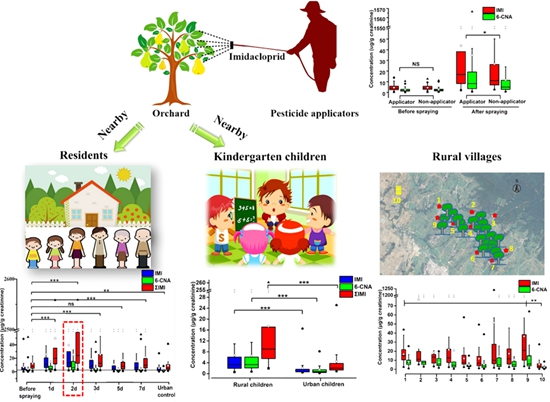Exploring the characteristics of human exposure to neonicotinoid imidacloprid in rural areas, China
Recently, the research group led by Prof. Zheng Yongquan from the Institute of Plant Protection, (IPP),CAAS, published a research paper titled “Characteristics of neonicotinoid imidacloprid in urine following exposure of humans to orchards in China” in Environment International. The research revealed the characteristics of human exposure to neonicotinoid imidacloprid by investigating people living in the Henan orchard areas where neonicotinoid imidacloprid are widely used as pesticides. This study provided valuable data support for health risk assessment of imidacloprid exposure in rural areas and laid strong foundation for future work on how to reduce the exposure risk for residents nearby.

Neonicotinoid insecticides are the most widely used pesticides, and the decline of pollinating vector insects caused by this type of insecticides has raised great concerns worldwide. In recent years, neonicotinoids have been shown to bind to mammalian acetylcholine receptor subtype (α4β2), whose concentration changes are associated with central nervous system disorders, including Alzheimer's, Parkinson's, schizophrenia, and depression, etc. The study selected a typical 10,000 acres of orchards in Henan Province and investigated 119 orchard planting families from 9 villages. The study population included 119 pesticide applicators and 156 family members, and 247 kindergarten children near imidacloprid-applied orchards. Meanwhile, 42 urban residents and 53 kindergarten children far away from rural areas were chosen as controls. Finally, 1926 urine samples were collected and measured. The results showed that imidacloprid and metabolite 6-chloronicotinic acid (6-CNA) were detected in 100% of urine samples; the concentrations of imidacloprid and 6-CNA in the urine of rural residents increased significantly in a short time after a spraying event (p < 0.05) and reached the highest concentration in the 2-d urine samples, and then gradually decreased with the extension of sampling time. As expected, all exposure concentrations in rural residents were higher than those of urban control samples; for 3-6 years-old children, urinary concentrations from rural group were significantly higher than that of urban group with a difference of 3.30-4.49 folds ; people from different villages demonstrated diverse exposure levels with a difference of 1.13-3.28 folds. The research demonstrated that rural populations in Henan agricultural areas were exposed to higher level of imidacloprid, which may cause potential health risks. Therefore, more attention should be paid on the effects of neonicotinoids on human health.
This research was funded by the National Key Research and Development Program of China (2016YFD0200204).
More information can be found via the link below:
https://www.sciencedirect.com/science/article/pii/S0160412019308451
By Dong Fengshou (fsdong@ippcaas.cn)
-
 Apr 18, 2024Opening Ceremony of the Training Workshop on Wheat Head Scab Resistance Breeding and Pest Control in Africa Held in CAAS
Apr 18, 2024Opening Ceremony of the Training Workshop on Wheat Head Scab Resistance Breeding and Pest Control in Africa Held in CAAS -
 Apr 03, 2024IPPCAAS Co-organized the Training Workshop on Management and Application of Biopesticides in Nepal
Apr 03, 2024IPPCAAS Co-organized the Training Workshop on Management and Application of Biopesticides in Nepal -
 Mar 28, 2024Delegation from the School of Agriculture and Food Science of University College Dublin, Ireland Visit to IAS, CAAS
Mar 28, 2024Delegation from the School of Agriculture and Food Science of University College Dublin, Ireland Visit to IAS, CAAS -
 Mar 25, 2024Director of World Food Prize Foundation visited GSCAAS
Mar 25, 2024Director of World Food Prize Foundation visited GSCAAS -
 Mar 20, 2024Institute of Crop Sciences (ICS) and Syngenta Group Global Seeds Advance Collaborative Research in the Seed Industry
Mar 20, 2024Institute of Crop Sciences (ICS) and Syngenta Group Global Seeds Advance Collaborative Research in the Seed Industry
